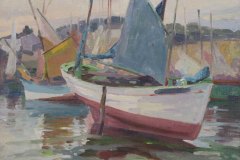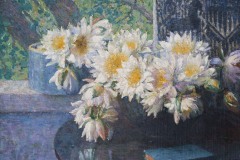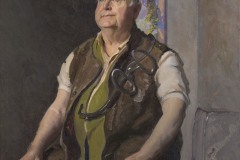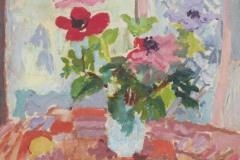The Johnson Collection would like to thank Wofford College for facilitating a virtual gallery talk with Sara Arnold, Director of Curatorial Affairs, Gibbes Museum of Art in Charleston, South Carolina, on “Central to Their Lives: Southern Women Artists in the Johnson Collection.” The Johnson Collection’s nationally-touring exhibition is on view at Wofford College in Spartanburg, South Carolina from September 7 to December 18, 2020. Learn more here: https://thejohnsoncollection.org/central-to-their-lives-southern-women-artists-in-the-johnson-collection/
Southern Women Artists in the Johnson Collection
“Art is central to my life. Not being able to make or see art would be a major deprivation.” Nell Blaine’s assertion about the centrality—the essentiality—of art to her life has a particular resonance. The Virginia painter’s creative path began early and over the course of her life, she overcame significant barriers in her quest to make and see art, including serious vision problems, polio, and paralysis. And then, there was her gender. In 1957, Blaine was hailed by Life magazine as someone to watch, profiled along with four other emerging painters whom the journalist praised “not as notable women artists but as notable artists who happen to be women.”
Spanning the decades between the late 1890s and early 1960s, this exhibition examines the particularly complex challenges Southern women artists confronted in a traditionally conservative region during a period in which women’s social, cultural, and political roles were being redefined and reinterpreted. How did the variables of historical gender norms, educational barriers, race, regionalism, sisterhood, suffrage, and modernism mitigate and motivate women seeking expression on canvas or in clay? Whether in personal or professional arenas? Working from studio space in spare rooms at home or on the world stage, the artists considered made remarkable contributions by fostering future generations of artists through instruction, incorporating new aesthetics into the fine arts, and challenging the status quo.
Hailed by The Magazine Antiques with having staged a “quiet art historical revolution” and expanding “the meaning of regional” through its “exhibitions, loans, publications, and institutional partnerships,” the Johnson Collection seeks to illuminate the rich history and diverse cultures of the American South. With holdings that offer an extensive survey of artistic activity from the late eighteenth century to the present day, the collection works to advance interest in the dynamic role that the art of the South plays in the larger context of American art and to contribute to the canon of art historical literature. Founded in 2002 as a private collection for public good, the Johnson Collection is located in Spartanburg, South Carolina.









